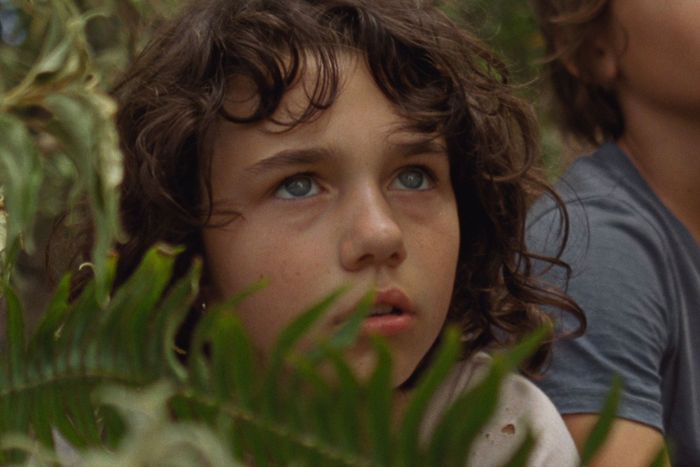
Some fairy tales are treasure troves for folklorists, who plumb their depths for themes and archetypes often shared by disparate cultures. Other fairy tales are best left unplumbed. Take J. M. Barrie’s play Peter Pan, which the writer-director Benh Zeitlin has reimagined and retitled Wendy. As in Zeitlin’s attention-grabbing debut, Beasts of the Southern Wild, the story is told in a freewheeling, imagistic style plainly influenced by Terrence Malick and similarly steeped in anxiety over civilization’s threat to the environment.
Zeitlin — who was raised by folklore scholars and has more or less remained in the family business — depicts the boy who refuses to grow up as a dreadlocked imp who is intimately connected to an undersea creature called Mother, who looks like a giant, shimmering catfish. Mother appears to represent Nature (and youth, and life, and hope, etc.) and communicates with her Lost Boys and Girls through geysers and volcanic eruptions on a remote island. Her aura is reminiscent of Barrie’s Tinker Bell, but the consequences of not believing in Mother’s mystical beneficence are far more dire: You promptly get old, are exiled from paradise, and develop piratical impulses. On paper, Zeitlin’s story ties together better than Peter Pan’s, in which the characters seem random — dogs who serve as nannies, Native American princesses, fairies who are applauded back to life, clock-swallowing crocodiles. But random turns out to be a hell of a lot more fun.
The movie’s prologue is the only thrilling part. Zeitlin’s titular heroine and narrator first appears as a toddler in her mother’s diner; it’s adjacent to a train station, and she watches a little boy celebrating his birthday throw a fit, wander out onto the tracks, climb a ladder to the top of a car, and go chugging off to who knows where. Years later, Wendy (Devin France) still lives upstairs from that diner and has identical twin brothers named Douglas and James (Gage and Gavin Naquin). Unlike the adults, she doesn’t just mourn the disappearance of that boy; she seems to envy him for having escaped. She wants adventure before she turns out like her mom, once a badass but now sagging under the weight of grown-up responsibilities. When Peter Pan (Yashua Mack) and his wayward shadow show up, the three children scamper after him onto a passing train and leave the swamps and the factories behind.
It’s an exhilarating trip until that island looms, whereupon Peter greets its belching volcano with “Hey, Mother! Happy to see you too!” That’s when I started to get confused. In the original Peter Pan, Wendy was whisked away to serve as a mother to the Lost Boys, who revel in their eternal youth but still — here’s the dramatic tension — crave maternal affection and guidance. Except there’s a mother here already: a mother of a mother, Mother Nature. There seems little for Wendy to do but watch the kids frolic with Sturla Brandth Grøvlen’s camera chasing after them (he looks to be getting in on the fun) and Dan Romer and Zeitlin’s score surging and swooping from crescendo to crescendo to manufacture and sustain momentum. The style is immersive, meant to envelop us and bring us into the story, but it ends up making the movie feel abstract and distant. And there’s a void at the center.
Mack’s Peter is either talking to Mother or on his own rascally wavelength. He seems much younger than Wendy, who doesn’t have much of a relationship with him. (When Barrie rewrote his play as a novel, he called it Peter and Wendy. Their bond is what holds the ramshackle fairy tale together.)
The pirate equivalents are a loose tribe of old men and women who loll around the arid part of the island lamenting the youth that was taken from them because they had sad thoughts and doubted themselves. They hate on Mother something fierce. One of them (whose identity is a surprise) loses a hand, acquires a hook, and hatches a plan to murder Mother, an act he is convinced will turn him back into a child — a baffling notion we have to accept or risk losing interest in the film altogether. By the time of the climactic duel, Zeitlin has managed to wind his way back to the specifics of Barrie’s Peter Pan but in a way that feels grimly intellectualized. Look, it’s Captain Hook — only without the arrrrs and the cool pirate costume and the paranoid fixation on a croc. Anything a kid (or the kid in us) would get excited about has been purged.
Beasts of the Southern Wild also unfolded on a semi-abstract plane, but it was grounded in a vivid, specific sense of place (the Louisiana bayou) and in the clear, watchful face of Quvenzhané Wallis as a moppet who scans the water and air for signals from her absent mother. Expressive as France’s Wendy is, we don’t feel the same sort of connection. Barrie’s heroine is wilting under a rigid, unfeeling mother in an England laboring to keep up appearances in the wake of Queen Victoria’s death, and for a limited time, she finds Peter’s refusal to grow up — his unyielding allegiance to anarchism — enchanting. The randomness of Barrie’s ingredients suggests a child asserting his freedom: I can too bring together pirates and Indians and crocodiles that go ticktock! He can and does, and the world is more magical for it, while Zeitlin’s island of abrasive kids, depressive senior citizens, a laser-beam-shooting catfish, and a hyperactive cinematographer feels more like art-house purgatory.
*This article appears in the March 2, 2020, issue of New York Magazine. Subscribe Now!


